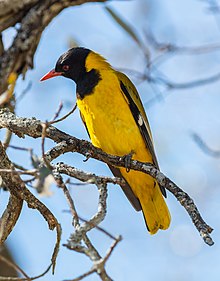Black-headed oriole
| Black-headed oriole | |
|---|---|

| |
Song recorded in the Masai Mara Game Reserve, Kenya | |
| Scientific classification | |
| Kingdom: | Animalia |
| Phylum: | Chordata |
| Class: | Aves |
| Order: | Passeriformes |
| Family: | Oriolidae |
| Genus: | Oriolus |
| Species: | O. larvatus
|
| Binomial name | |
| Oriolus larvatus Lichtenstein, 1823
| |

The black-headed oriole (Oriolus larvatus) is a species of bird in the family Oriolidae. It is found in Africa and has a very striking appearance with a bright yellow body, contrasting black head and flesh-coloured beak.
Taxonomy and systematics[]
Some authorities have considered the mountain oriole to be a subspecies of the black-headed oriole. Alternate names for the black-headed oriole include the African black-headed oriole, Eastern black-headed oriole and Eastern oriole.
Subspecies[]
Five subspecies are recognized:[2]
- O. l. rolleti - Salvadori, 1864: Originally described as a separate species. Found from southern Sudan and southern Ethiopia to eastern Democratic Republic of Congo and central Kenya
- O. l. reichenowi - Zedlitz, 1916: Found from Somalia to eastern Tanzania
- Kenya black-headed oriole (O. l. angolensis) - Neumann, 1905: Found from Angola and Namibia to western Tanzania and northern Mozambique
- O. l. tibicen - , 1962: Found from coastal southern Tanzania to coastal southern Mozambique
- O. l. larvatus - Lichtenstein, MHK, 1823: Found from southern Zimbabwe to inland southern Mozambique and eastern South Africa
Description[]
The black-headed oriole has a bright yellow body, contrasting black head and flesh-coloured beak. The voice is a liquid-sounding warble, accompanied by imitations and whistles.
Distribution and habitat[]
It breeds in much of sub-Saharan Africa from South Sudan and Ethiopia in the north to South Africa in the south.
It inhabits dry tropical forests, especially acacia and broad-leaved woodlands, and dense shrubland areas, where it is more often heard than seen despite the brightness of its plumage.
Behaviour and ecology[]
The black-headed oriole forages in the canopy, feeding on small fruit as well as large insects. The young are fed mostly with caterpillars.
Gallery[]

A pair in courtship ritual, riparian zone of central Waterberg, South Africa

Tail-fanning is one element of oriole courtship[3]

Exemplar in Kruger National Park, South Africa.
References[]
- ^ BirdLife International (2016). "Oriolus larvatus". IUCN Red List of Threatened Species. 2016: e.T22706421A94068822. doi:10.2305/IUCN.UK.2016-3.RLTS.T22706421A94068822.en. Retrieved 19 November 2021.
- ^ "IOC World Bird List 7.1". IOC World Bird List Datasets. doi:10.14344/ioc.ml.7.1.
- ^ "HBW 13 - Family text: Oriolidae (Orioles and Figbirds)". Handbook of the Birds of the World Alive. Lynx Edicions, Barcelona. Archived from the original on 19 May 2016. Retrieved 14 September 2016.
External links[]
- Black-headed oriole videos, photos and sounds - Internet Bird Collection
- Black-headed oriole - Species text in The Atlas of Southern African Birds.
- IUCN Red List least concern species
- Orioles
- Oriolus
- Birds of Sub-Saharan Africa
- Birds described in 1823



